By Ken Neubecker, Regional Vice President, Colorado Trout Unlimited The City of Aspen is planning to build a pair of dams in some of Colorado’s most iconic mountain landscapes and streams. One is slated for Maroon Creek, just below the Maroon Bells, and the other on Castle Creek not far below the old town of Ashcroft. These dams would inundate significant portions of these free-flowing streams along with portions of the Maroon Bells-Snowmass Wilderness. Why is this coming up now? Because the City must go to Water Court every six years and demonstrate that they are working to build these dams.
This is not a good thing. Aspen has no need for these dams and reservoirs, no need to wreck these streams or the landscapes they inhabit. Colorado TU, along with partners at American Rivers, Western Resource Advocates and Wilderness Workshop are planning to object to these dams in Water Court.
 Back in the 1960’s planners thought that Aspen’s population (1,101 in 1960) would reach 30,000 by the end of the century and that additional water supplies would be necessary. Aspen’s population didn’t grow much. In 2000 it was up to 5,914 and by 2010 had added less than a thousand more. Looking forward, the City’s population isn’t expected to grow much more over the next 60 years either, yet Aspen continues to hang on to the notion that they might, someday, need these destructive dams and reservoirs.
Back in the 1960’s planners thought that Aspen’s population (1,101 in 1960) would reach 30,000 by the end of the century and that additional water supplies would be necessary. Aspen’s population didn’t grow much. In 2000 it was up to 5,914 and by 2010 had added less than a thousand more. Looking forward, the City’s population isn’t expected to grow much more over the next 60 years either, yet Aspen continues to hang on to the notion that they might, someday, need these destructive dams and reservoirs.
But they don’t, and the City itself claims they’ll probably never build them. Aspen currently holds a substantial portfolio of senior water rights on both streams. According to a study the City itself commissioned these existing rights can accommodate all projected water needs for the rest of this century even in the face of extreme climate change (City of Aspen Water Supply Availability Study, 2016 Update, June 2016).
So why is the City pursuing their conditional rights for dams they admit they will never probably build? Prudence is the excuse, but not a good reason. What the City is saying in court contradicts what they are saying in public. In court, they must say that they “can and will” build the dams. In public they say they probably won’t, but want to preserve the option. Preserving an option, to maybe, or then again maybe not, build the dams may sound prudent but it is not acceptable in Water Court. They either will, or they won’t. There is no “maybe”. Aspen can’t have it both ways.
Aspen’s primary argument is that they may need these additional water sources due to potential impacts from climate change. Climate change is a legitimate concern for water supply, but these dams will not help. Most models show that runoff and river flows will diminish throughout the Colorado River Basin, from Aspen downstream to the delta.
Aspen doesn’t exist in isolation from the rest of Colorado or the larger Colorado River basin. A 2012 study by the Bureau of Reclamation (BOR) suggests that “the mean natural flow (of the Colorado River) … is projected to decrease by approximately 9%” by 2060. That means an additional 3.2 million acre-foot deficit in what is already a seriously depleted system (an acre-foot is about 326,000 gallons, or about what two normal families will use in a year). The BOR report also anticipates an “increase in drought frequency and duration”. Lake Powell is currently only half full, and Lake Mead even less (38%). Water shortage in the Colorado Basin is likely to be with us for a long time.
Colorado signed a compact with all the other Colorado River basin states in 1922. This compact requires that a certain amount of water be left in the river for the lower basin. If we do find ourselves amid a major water shortage the demands from the lower basin states will drain any reservoir with such junior rights as Aspen’s (1971). And there are numerous pre-1922 rights downstream that will also demand any water that might be stored behind these dams.
The dams would become empty monuments to the past, straddling diminished streams in what used to be vital and dynamic ecosystems.
Aspen does not need these dams and reservoirs. If they are truly prudent, and progressive, they never will. The people of Aspen would be much better served if the City dropped these outdated dams and develops real solutions that ensure both a reliable water supply and the important ecosystems of Castle and Maroon Creeks. Intact and fully functioning stream ecosystems are a much better hedge against climate change than a pair of outdated and useless dams.
CTU and its partners are willing and able to work with Aspen to develop realistic and modern 21st century solutions for future water needs. Aspen, of all places, can and should take a leadership role and not just keep kicking the can of outdated ideas down the road. We need to work with these streams, not against them.






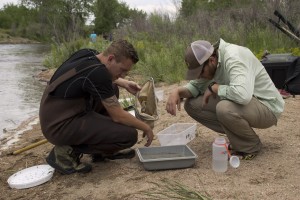
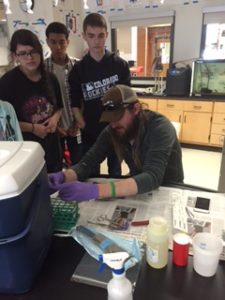 In Colorado, there are currently six active tanks involved with the TIC program. These classrooms are located all over Colorado. CTU helps these classrooms by assisting in obtaining trout eggs, coordinating supplies, and helping with the required disease testing prior to the release.
In Colorado, there are currently six active tanks involved with the TIC program. These classrooms are located all over Colorado. CTU helps these classrooms by assisting in obtaining trout eggs, coordinating supplies, and helping with the required disease testing prior to the release. Parents have also gotten into the fun through TIC. "While the program is targeted at the kids, the teachers involved have noted that many of the parents have been excited about the tanks as well, not only keeping up with the egg/fry progress through their children, but visiting the tanks during parent-teacher conferences, involving the whole family in the educational process," said Bloodworth.
Parents have also gotten into the fun through TIC. "While the program is targeted at the kids, the teachers involved have noted that many of the parents have been excited about the tanks as well, not only keeping up with the egg/fry progress through their children, but visiting the tanks during parent-teacher conferences, involving the whole family in the educational process," said Bloodworth. 1. Use Yarn- many of you reading this may have heard this recommendation before, but it bears repeating. I feel that strongly about it. Simply put, yarn indicators are WAY more sensitive than plastic bobber-style indicators. Fish this time of year can be pretty lethargic (compared to summer) and typically won’t eat your flies with much aggression. Oftentimes your yarn won’t even dunk underwater but rather just ‘pause’ or ‘lean over’ when a fish strikes. If you’ve never used yarn indicators before, be prepared to be amazed with the sensitivity you’ll get. Side note- tips for yarn success- carry several and liberally apply some fly floatant before starting the day. Be prepared to dry off your indicator every couple hours and reapply. If you decide that your indicator is too waterlogged after a few hours, simply swap it out for a fresh one. While I realize these do require a little more maintenance than a thingamabobber, the fact that it leads to more fish in the net throughout the day is always worth it to me.
1. Use Yarn- many of you reading this may have heard this recommendation before, but it bears repeating. I feel that strongly about it. Simply put, yarn indicators are WAY more sensitive than plastic bobber-style indicators. Fish this time of year can be pretty lethargic (compared to summer) and typically won’t eat your flies with much aggression. Oftentimes your yarn won’t even dunk underwater but rather just ‘pause’ or ‘lean over’ when a fish strikes. If you’ve never used yarn indicators before, be prepared to be amazed with the sensitivity you’ll get. Side note- tips for yarn success- carry several and liberally apply some fly floatant before starting the day. Be prepared to dry off your indicator every couple hours and reapply. If you decide that your indicator is too waterlogged after a few hours, simply swap it out for a fresh one. While I realize these do require a little more maintenance than a thingamabobber, the fact that it leads to more fish in the net throughout the day is always worth it to me.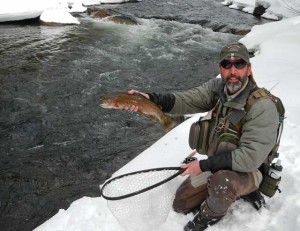 Whenever you approach a likely looking area, always make it a point to fish it while keeping your wading boots on dry ground. Avoiding splashing around, crunching rocks, and in general- disturbing the water with your steps- is always going to leave the fish feeling much more at ease and in turn- more eager to eat your flies (this rule should actually be applied year round).
Whenever you approach a likely looking area, always make it a point to fish it while keeping your wading boots on dry ground. Avoiding splashing around, crunching rocks, and in general- disturbing the water with your steps- is always going to leave the fish feeling much more at ease and in turn- more eager to eat your flies (this rule should actually be applied year round). 5. Watch the bubbles- we’ve already talked about indicators and weight, and I firmly believe that one of the biggest reasons people don’t catch as many fish as they should is that they’re simply not getting down to them. Next time your nymphing make sure to keep an eye on the bubbles on the surface. What are they doing? Are they moving the same speed as your indicator? If so, this is a dead giveaway you’re not getting down to the fish. Most fish this time of year are sitting very close to the bottom. The water on the bottom of the river is moving slower than the water on the surface. If you’re indicator is floating the same speed as the bubbles on the surface, this means that you’re not getting down to the fish. Simple as that. The goal is to always have your indicator floating SLOWER than the bubbles on the surface. This can quickly be achieved by adding a little more depth and/or weight to your rig. If you’ve never paid attention to this before I think you’ll be amazed at how much of a difference it makes and how quickly you are now able to dial in your rig, ultimately achieving a perfect drift to the fish!
5. Watch the bubbles- we’ve already talked about indicators and weight, and I firmly believe that one of the biggest reasons people don’t catch as many fish as they should is that they’re simply not getting down to them. Next time your nymphing make sure to keep an eye on the bubbles on the surface. What are they doing? Are they moving the same speed as your indicator? If so, this is a dead giveaway you’re not getting down to the fish. Most fish this time of year are sitting very close to the bottom. The water on the bottom of the river is moving slower than the water on the surface. If you’re indicator is floating the same speed as the bubbles on the surface, this means that you’re not getting down to the fish. Simple as that. The goal is to always have your indicator floating SLOWER than the bubbles on the surface. This can quickly be achieved by adding a little more depth and/or weight to your rig. If you’ve never paid attention to this before I think you’ll be amazed at how much of a difference it makes and how quickly you are now able to dial in your rig, ultimately achieving a perfect drift to the fish! Why did you become a member and what chapter are you involved with?
Why did you become a member and what chapter are you involved with?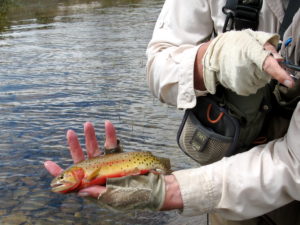
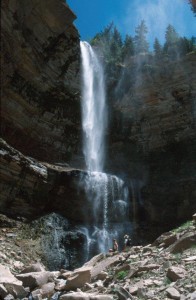

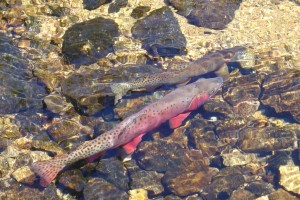
 Colorado TU teamed up with Colorado Parks and Wildlife to reintroduce Greenback Cutthroat trout into their native watersheds all along the Front Range. Efforts this past year including spawning
Colorado TU teamed up with Colorado Parks and Wildlife to reintroduce Greenback Cutthroat trout into their native watersheds all along the Front Range. Efforts this past year including spawning 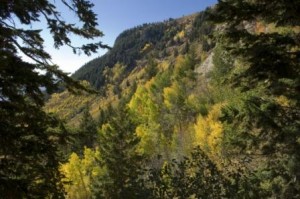
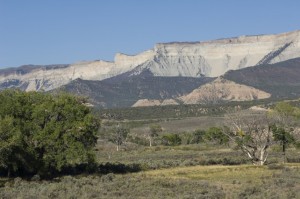 The MLP process is a new tool that promises to address some of that top-down, fragmented approach to public land management. To their credit, the BLM is listening and incorporating suggestions from local ranchers, conservation groups and elected officials into their leasing plan for South Park.
The MLP process is a new tool that promises to address some of that top-down, fragmented approach to public land management. To their credit, the BLM is listening and incorporating suggestions from local ranchers, conservation groups and elected officials into their leasing plan for South Park. The Roan Plateau is home to outstanding big game habitat and unique native trout like those pictured here. Trout Unlimited has been hard at work on the Roan for more than two decades, with many hundreds of volunteer hours invested by the Grand Valley Anglers chapter on habitat protection and improvement projects from instream structures to riparian fencing and replanting. TU also helped install a fish barrier to protect native cutthroat trout habitat being restored by Colorado Parks and Wildlife.
The Roan Plateau is home to outstanding big game habitat and unique native trout like those pictured here. Trout Unlimited has been hard at work on the Roan for more than two decades, with many hundreds of volunteer hours invested by the Grand Valley Anglers chapter on habitat protection and improvement projects from instream structures to riparian fencing and replanting. TU also helped install a fish barrier to protect native cutthroat trout habitat being restored by Colorado Parks and Wildlife. The Thompson Divide (including Thompson Creek pictured here) makes up more than 220,000 acres of federal land in Pitkin, Garfield, Gunnison and Mesa counties and contains some of Colorado's most productive habitat for big game, cutthroat trout and numerous other native species. The area is used by more than 10,000 resident and nonresident big game hunters every year and serves as the headwaters to some of Colorado’s most popular fisheries including the Roaring Fork, North Fork of the Gunnison, and Crystal River.
The Thompson Divide (including Thompson Creek pictured here) makes up more than 220,000 acres of federal land in Pitkin, Garfield, Gunnison and Mesa counties and contains some of Colorado's most productive habitat for big game, cutthroat trout and numerous other native species. The area is used by more than 10,000 resident and nonresident big game hunters every year and serves as the headwaters to some of Colorado’s most popular fisheries including the Roaring Fork, North Fork of the Gunnison, and Crystal River.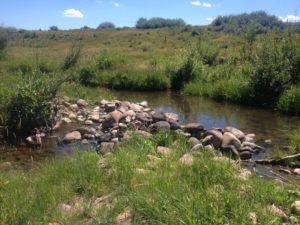 A small creek in southwest Wyoming just got a big upgrade. This November, a push-up style diversion was improved to a fish-friendly rock vane structure with a head-gate, reconnecting approximately 6 miles of habitat for the native Colorado River cutthroat trout that reside there. This project was unique in that it all began with the local school. Trout Unlimited partnered with the McKinnon Elementary School to study their home water, the Henry’s Fork River, through the Adopt-a-Trout program. This particular program involved tagging Colorado River cutthroat trout with telemetry tags and tracking their movement from 2014-2016. The students each got to “adopt” their own fish and follow it throughout the year. They learned a variety of river ecology lessons, including fish anatomy, macroinvertebrate identification, applying the scientific method, riparian ecosystems and many more. They also had to map where their fish moved using Google Earth.
A small creek in southwest Wyoming just got a big upgrade. This November, a push-up style diversion was improved to a fish-friendly rock vane structure with a head-gate, reconnecting approximately 6 miles of habitat for the native Colorado River cutthroat trout that reside there. This project was unique in that it all began with the local school. Trout Unlimited partnered with the McKinnon Elementary School to study their home water, the Henry’s Fork River, through the Adopt-a-Trout program. This particular program involved tagging Colorado River cutthroat trout with telemetry tags and tracking their movement from 2014-2016. The students each got to “adopt” their own fish and follow it throughout the year. They learned a variety of river ecology lessons, including fish anatomy, macroinvertebrate identification, applying the scientific method, riparian ecosystems and many more. They also had to map where their fish moved using Google Earth.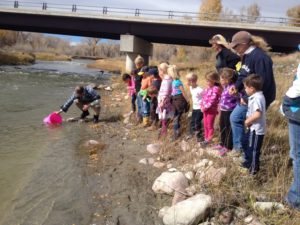 Using two years of the Adopt-a-Trout data and an instream flow study that TU conducted on Beaver Creek, a major tributary, we discovered that there was a push-up dam near the confluence to the Henry’s Fork that was not allowing fish passage for a critical part of the year. None of the students’ fish were able to pass that point during the summer months. So, TU collaborated with the Lonetree Ranch to develop a fish-friendly diversion that would still allow them to receive their irrigation water, but would allow for fish passage during low flows. A head-gate was also installed so that they could turn the ditch off when they no longer needed to irrigate, leaving more water instream for the trout. Thanks to the funding provided by the Wyoming Landscape Conservation Initiative, the Wyoming Wildlife Natural Resource Trust and the Natural Resources Conservation Service, the project was able to be completed November 2016.
Using two years of the Adopt-a-Trout data and an instream flow study that TU conducted on Beaver Creek, a major tributary, we discovered that there was a push-up dam near the confluence to the Henry’s Fork that was not allowing fish passage for a critical part of the year. None of the students’ fish were able to pass that point during the summer months. So, TU collaborated with the Lonetree Ranch to develop a fish-friendly diversion that would still allow them to receive their irrigation water, but would allow for fish passage during low flows. A head-gate was also installed so that they could turn the ditch off when they no longer needed to irrigate, leaving more water instream for the trout. Thanks to the funding provided by the Wyoming Landscape Conservation Initiative, the Wyoming Wildlife Natural Resource Trust and the Natural Resources Conservation Service, the project was able to be completed November 2016.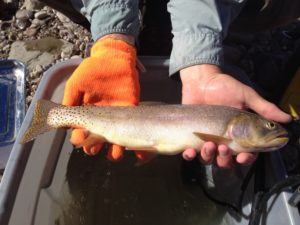 This is just the first of many projects that will be done along Beaver Creek to benefit native trout. Over the next year, the McKinnon students will be assisting with vegetation planting and monitoring on several sections right above the diversion to provide better cover and reduce stream temperatures during the summer months. Projects like these are not only reconnecting populations of native trout, but reconnecting kids to “their” fish and river.
This is just the first of many projects that will be done along Beaver Creek to benefit native trout. Over the next year, the McKinnon students will be assisting with vegetation planting and monitoring on several sections right above the diversion to provide better cover and reduce stream temperatures during the summer months. Projects like these are not only reconnecting populations of native trout, but reconnecting kids to “their” fish and river.
